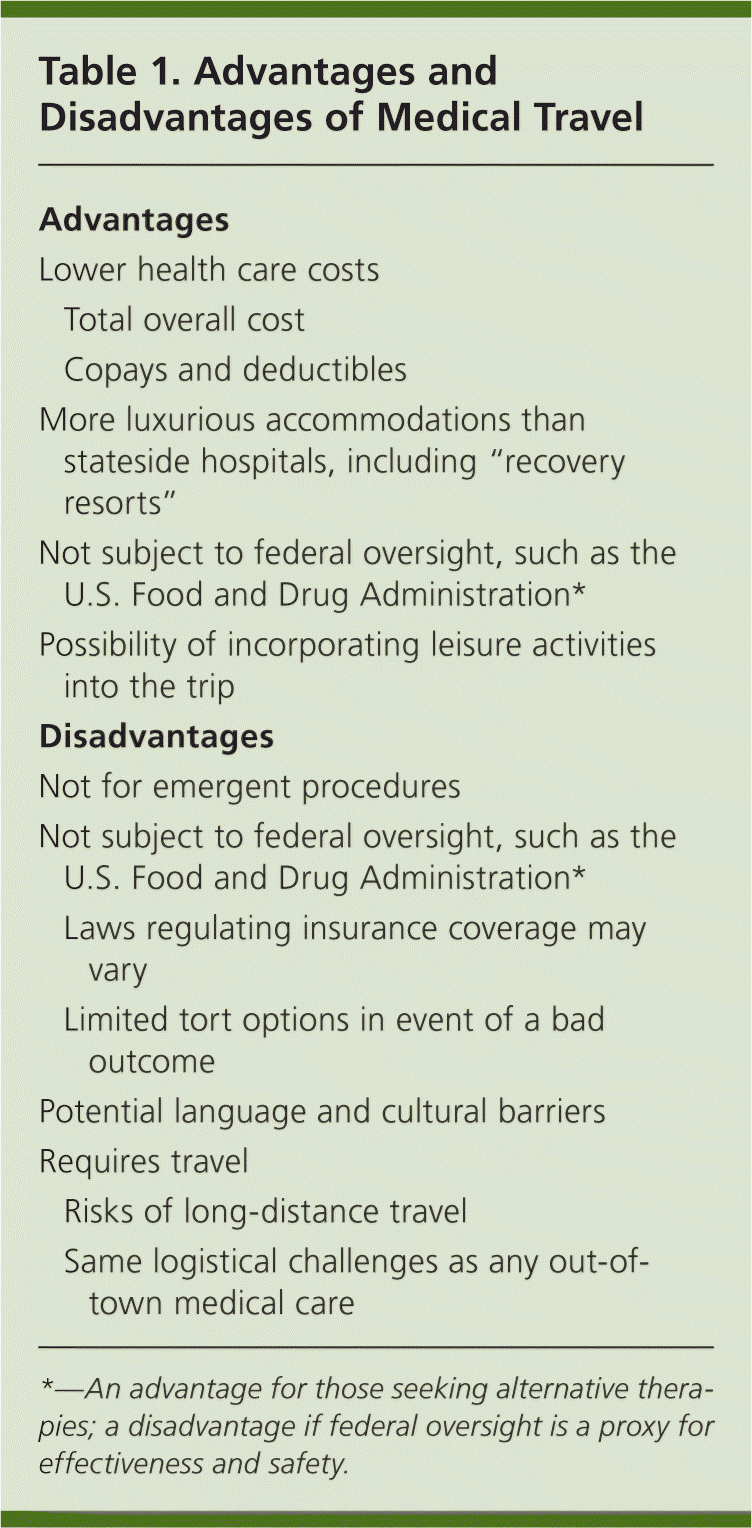
Am Fam Physician. 2011;84(8):863-864
Author disclosure: No relevant financial affiliations to disclose.
The face of medical travel is changing. Traveling abroad in search of quality health care was once the purview of wealthy foreigners entering the United States for better care than that in their homelands, and Americans going to other countries for unconventional therapies not available or approved in the United States. In recent years, however, medical travel has expanded to include middle-class patients seeking more affordable care. In 2007, approximately 750,000 Americans traveled to other countries for medical care; this number is predicted to exceed 1.6 million in 2012.1 Table 1 includes advantages and disadvantages of medical travel.

| Advantages | |
| Lower health care costs | |
| Total overall cost | |
| Copays and deductibles | |
| More luxurious accommodations than stateside hospitals, including “recovery resorts” | |
| Not subject to federal oversight, such as the U.S. Food and Drug Administration* | |
| Possibility of incorporating leisure activities into the trip | |
| Disadvantages | |
| Not for emergent procedures | |
| Not subject to federal oversight, such as the U.S. Food and Drug Administration* | |
| Laws regulating insurance coverage may vary | |
| Limited tort options in event of a bad outcome | |
| Potential language and cultural barriers | |
| Requires travel | |
| Risks of long-distance travel | |
| Same logistical challenges as any out-of-town medical care | |
Patients seek a variety of nonemergent medical procedures abroad, ranging from dentistry and orthopedic procedures to cardiac surgeries.2 Destinations include highly industrialized nations, where medical facilities use the same brands of implants, prostheses, and other supplies that are used in the United States; physicians are trained to Western standards; and hospitals are accredited by the Joint Commission International, an arm of the organization that oversees U.S. hospitals. A sign that medical travel has become mainstream is the inclusion of overseas hospitals in the network of a major U.S. health insurer, and its launch of a subsidiary with policies that provide incentives for patients to use these offshore medical facilities for high-priced items.3 Other payers are also exploring this option.1
When carried out as intended, many of the principles of the patient-centered medical home may be applied to medical care abroad, including a personal physician who is the first point of contact, provides continuous and comprehensive care, leads the health care team, coordinates and integrates care, and tracks quality and safety.4 This is relevant whether the patient is admitted across town to the local hospital, across the state to a major referral center, or across borders as part of medical travel.
An Internet search for medical tourism yields an array of Web sites, ranging from spas to surgical centers. It can be a challenge to sort through the options. Good places to start include the Medical Tourism Association (http://www.medicaltourism.com), Healthcare Tourism International (http://www.healthcaretrip.org), and the International Medical Travel Journal (http://www.imtj.com). These resources allow patients and physicians to explore the opportunities by procedure and destination.
Safety and quality of health care are appropriate concerns with medical travel. It is prudent to work only with facilities credentialed through members of the International Society for Quality in Health Care (http://www.isqua.org); the Joint Commission International is a member that credentials more than 400 facilities in 39 nations.5 Although physicians overseas are credentialed by their respective hospitals, some also participate in the International Board of Medicine and Surgery (http://www.ibms.us), an independent association that certifies health care professionals via documentation of licensure, specialty certification, and hospital affiliation. Such certification can provide additional peace of mind. Other organizations designed to monitor factors such as patient safety, complications, and outcomes are also under development to complement physician credentialing bodies. U.S. third-party payers have a strong liability incentive to closely monitor the quality of their affiliated facilities and health care professionals abroad. Seeking out these hospitals and physicians for care is wise even for patients without insurance coverage from these payers.
Before a patient travels abroad for medical care, appropriate preparatory care should be completed, including a hybrid of the preoperative and pretravel consultations. Identifying and mitigating risk factors for perioperative morbidity and mortality are important before any surgery, and especially before medical travel.6 Inadequate preoperative health assessment could lead to the procedure being postponed or cancelled after substantial travel. The findings of the preoperative evaluation should be communicated to the surgical team in a timely fashion. Many destinations for medical travel have endemic diseases, and appropriate counseling and prophylactic measures should be offered to the patient and anyone accompanying the patient. Pretravel care for patients seeking medical care abroad is well within the scope of a family physician practice.7
Aftercare should be completed when a patient returns from medical travel. In many ways, this is not unlike the care received after hospitalization in an out-of-town referral center. Good communication between the surgeon and family physician before medical travel greatly enhances the likelihood of good communication afterward and facilitates appropriate continuity of care. Political pressures (e.g., family physician's employer views offshore care as “competition”) must not be allowed to interfere with patient care. In addition to managing any traditional postoperative complications, physicians should be vigilant about monitoring for travel-related complications, such as thromboembolism and infections (e.g., malaria).
In the global community in which we live, medical travel is inevitable. U.S. physicians should be prepared to apply the principles of the patient-centered medical home to patients traveling abroad—leading the health care team, and coordinating and integrating their patients' care, wherever that may be.
